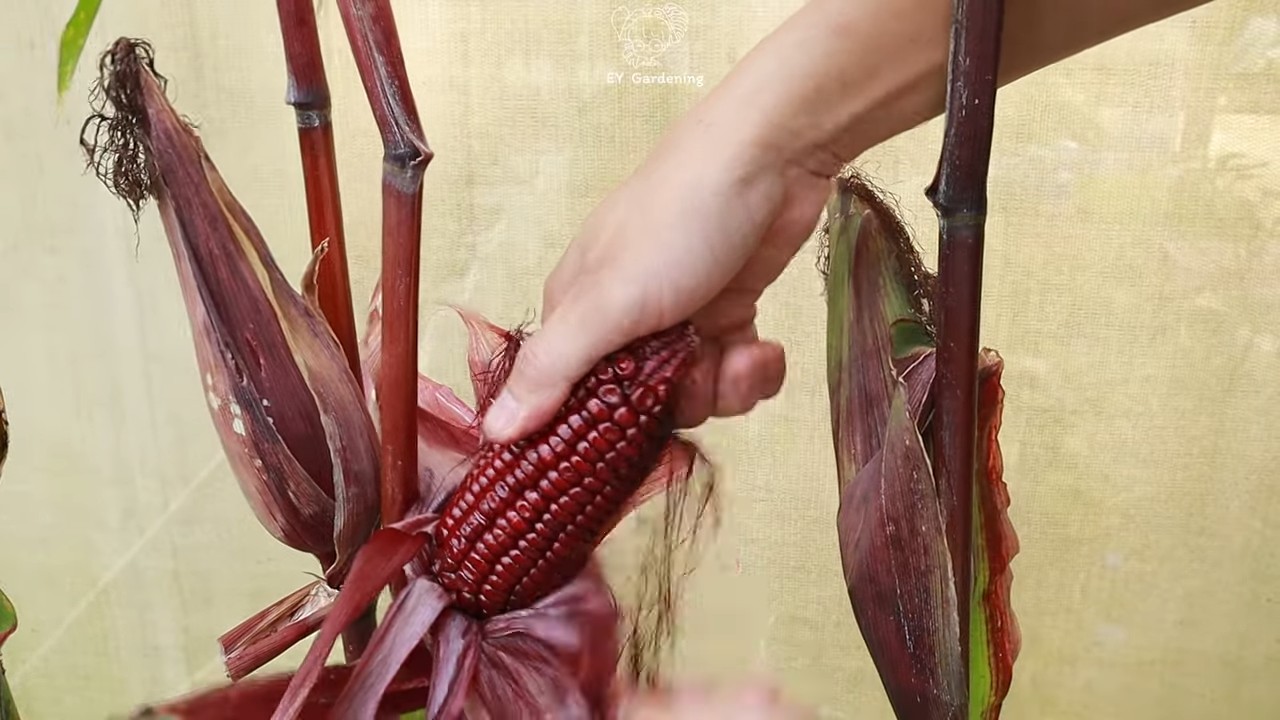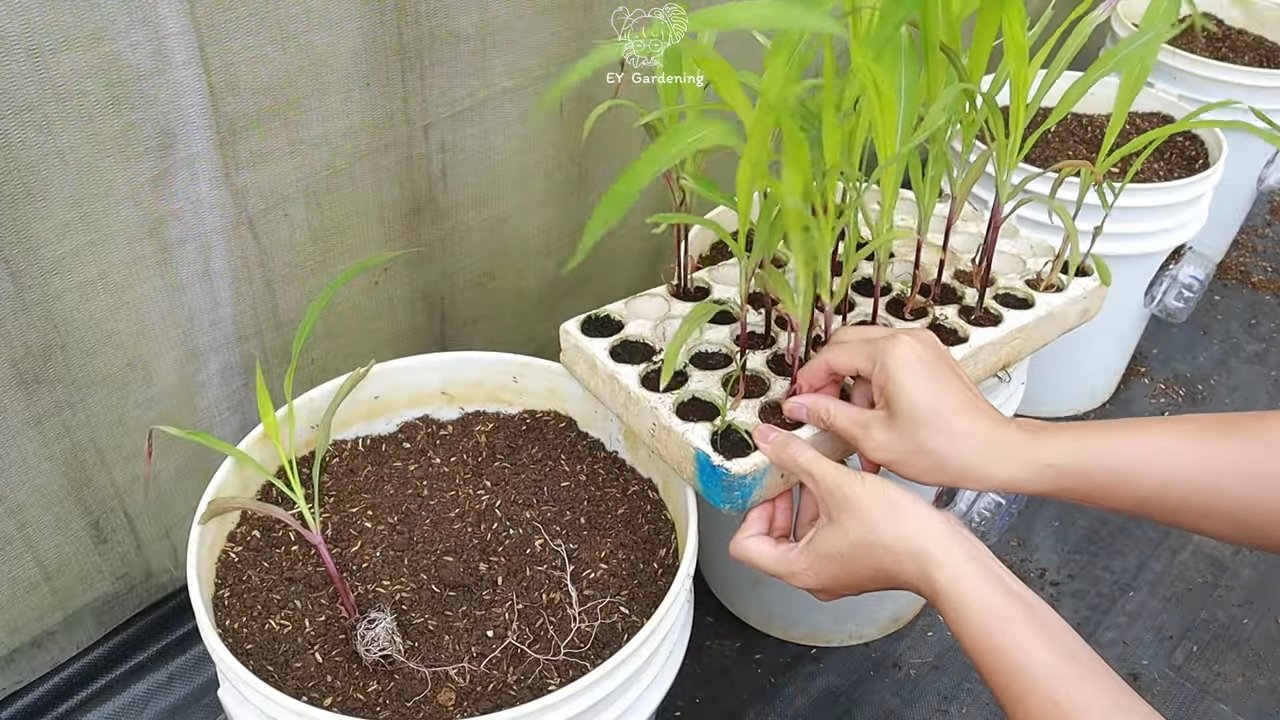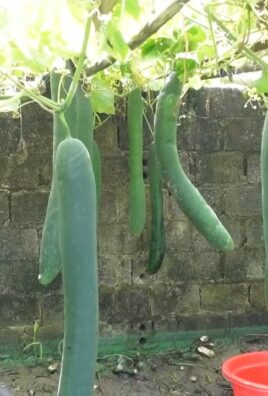Purple corn growing hacks are about to revolutionize your garden! Forget everything you thought you knew about growing corn because we’re diving deep into the vibrant world of purple corn. Have you ever imagined rows of stunning, deep purple stalks swaying gently in your backyard? It’s not just a dream; it’s an achievable reality with the right know-how.
Purple corn isn’t just a pretty face; it boasts a rich history, particularly in South America, where it has been cultivated for centuries. In Peru, for example, it’s known as “Maíz Morado” and is used to make a refreshing drink called “chicha morada.” Beyond its cultural significance, purple corn is packed with antioxidants, making it a healthy and delicious addition to your diet.
But let’s be honest, growing purple corn can be a little tricky. That’s where these DIY hacks come in! I’m going to share some of my favorite tips and tricks to help you cultivate a thriving purple corn patch, even if you’re a beginner gardener. From soil preparation secrets to pest control strategies, we’ll cover everything you need to know. Why struggle with lackluster yields when you can unlock the full potential of your purple corn with these simple, effective techniques? Let’s get growing!

Unlocking the Secrets to Vibrant Purple Corn: A DIY Growing Guide
Hey there, fellow gardening enthusiasts! I’m so excited to share my tried-and-true methods for growing stunning, deeply pigmented purple corn. It’s not just a beautiful addition to your garden; it’s also packed with antioxidants and makes for some seriously impressive cornmeal, tortillas, and even purple corn juice! Trust me, once you taste the difference, you’ll be hooked.
This guide will walk you through everything you need to know, from selecting the right seeds to harvesting your vibrant purple treasure. Let’s get started!
Choosing the Right Purple Corn Variety
Before we even think about planting, it’s crucial to pick the right variety of purple corn. Not all purple corn is created equal! Some are better suited for certain climates, and others are specifically bred for different uses. Here’s a breakdown of some popular choices:
* ‘Blue Hopi’: This is a classic choice, known for its deep blue-purple kernels and drought tolerance. It’s a great option if you live in a drier climate.
* ‘Cherokee White Eagle’: While the name might be misleading, this variety produces ears with a mix of white and purple kernels. It’s a beautiful and unique option.
* ‘Oaxacan Purple’: This variety hails from Mexico and is prized for its intense purple color and delicious flavor. It’s often used for making traditional Mexican beverages.
* ‘Purple Inca’: A relatively new variety, ‘Purple Inca’ is known for its high anthocyanin content (the pigment that gives it its purple color) and excellent flavor.
Key Considerations When Choosing:
* Climate: Consider your local climate and choose a variety that is well-suited to your growing conditions.
* Intended Use: Are you planning to make cornmeal, tortillas, or something else? Different varieties have different flavor profiles and textures.
* Days to Maturity: Pay attention to the “days to maturity” listed on the seed packet. This will give you an idea of how long it will take for your corn to be ready for harvest.
Preparing Your Garden for Purple Majesty
Purple corn, like all corn, is a heavy feeder, meaning it needs a lot of nutrients to thrive. Proper soil preparation is essential for a successful harvest.
* Sunlight: Corn needs at least 6-8 hours of direct sunlight per day. Choose a location in your garden that receives plenty of sun.
* Soil: Purple corn prefers well-drained soil that is rich in organic matter.
* pH: The ideal soil pH for corn is between 6.0 and 7.0.
Step-by-Step Soil Preparation:
1. Clear the Area: Remove any weeds, rocks, or debris from the planting area.
2. Amend the Soil: This is where the magic happens! Incorporate plenty of compost, well-rotted manure, or other organic matter into the soil. I like to use a combination of compost and aged chicken manure. Aim for a layer that’s about 2-4 inches thick.
3. Till or Dig: Use a tiller or garden fork to work the amendments into the soil to a depth of at least 12 inches. This will help improve drainage and aeration.
4. Test Your Soil (Optional): If you’re unsure about your soil’s pH or nutrient levels, consider getting a soil test. This will give you valuable information about what amendments you need to add. You can usually get a soil test done through your local agricultural extension office.
5. Level the Soil: Rake the soil smooth and level.
Planting Your Purple Corn Seeds
Now for the fun part – planting! Corn is wind-pollinated, so it’s important to plant it in blocks rather than long, single rows. This will help ensure good pollination and a bountiful harvest.
* Timing: Plant your purple corn seeds after the last frost in your area. The soil temperature should be at least 60°F (15°C).
* Spacing: Plant seeds 1-2 inches deep and about 6-12 inches apart within rows. Space rows 24-36 inches apart.
* Planting Pattern: Plant in blocks of at least four rows to ensure good pollination.
Detailed Planting Instructions:
1. Create Furrows: Use a hoe or trowel to create furrows in the prepared soil, spaced according to your chosen row spacing.
2. Sow the Seeds: Drop the seeds into the furrows, spacing them according to your chosen plant spacing.
3. Cover the Seeds: Gently cover the seeds with soil and pat it down lightly.
4. Water Thoroughly: Water the planted area thoroughly to help the seeds germinate.
Nurturing Your Purple Corn Plants
Once your purple corn seedlings emerge, it’s important to provide them with the care they need to thrive.
* Watering: Corn needs consistent moisture, especially during tasseling and silking (when the tassels and silks appear). Water deeply whenever the top inch of soil feels dry.
* Fertilizing: Corn is a heavy feeder, so regular fertilization is essential. Side-dress your plants with a nitrogen-rich fertilizer when they are about 12 inches tall and again when they begin to tassel. I like to use a balanced organic fertilizer.
* Weeding: Keep the area around your corn plants free of weeds. Weeds compete with corn for nutrients and water.
* Pest Control: Keep an eye out for common corn pests, such as corn earworms and corn borers. Use organic pest control methods, such as hand-picking pests or using insecticidal soap.
Specific Care Tips:
* Side-dressing: To side-dress, sprinkle fertilizer along the rows of corn, about 6 inches away from the plants. Gently work the fertilizer into the soil and water thoroughly.
* Watering During Tasseling and Silking: This is a critical time for watering. Make sure your corn plants receive plenty of water during this period to ensure good pollination and kernel development.
* Hand-picking Pests: For smaller infestations, hand-picking pests can be an effective way to control them. Simply remove the pests from the plants and dispose of them.
Pollination Perfection: Ensuring a Bountiful Harvest
As I mentioned earlier, corn is wind-pollinated. This means that the pollen from the tassels (the male flowers at the top of the plant) needs to reach the silks (the female flowers that emerge from the developing ears) in order for the kernels to develop.
* Encourage Pollination: If you live in an area with little wind, you can help the pollination process by gently shaking the corn stalks when the tassels are shedding pollen.
* Hand Pollination (Optional): For even more control, you can hand-pollinate your corn. To do this, collect pollen from the tassels in a paper bag and then gently dust the silks with the pollen.
Hand-Pollination Steps:
1. Collect Pollen: In the early morning, when the tassels are shedding pollen, gently shake the tassels over a paper bag to collect the pollen.
2. Apply Pollen to Silks: Gently dust the silks of each ear of corn with the collected pollen.
3. Repeat: Repeat this process for several days to ensure that all of the silks are pollinated.
Harvesting Your Purple Corn
The moment we’ve all been waiting for! Knowing when to harvest your purple corn is key to getting the best flavor and texture.
* Timing: Harvest your purple corn when the silks have turned brown and dry, and the kernels are plump and firm. The husks should still be slightly green.
* Testing for Ripeness: To test for ripeness, peel back a portion of the husk and puncture a kernel with your fingernail. If a milky liquid squirts out, the corn is ready to harvest.
* Harvesting Technique: Grasp the ear of corn firmly and twist it downward to snap it off the stalk.
Detailed Harvesting Instructions:
1. Check for Ripeness: Examine the silks and kernels to determine if the corn is ready for harvest.
2. Peel Back the Husk: Gently peel back a portion of the husk to expose the kernels.
3. Puncture a Kernel: Puncture a kernel with your fingernail to check for milky liquid.
4. Harvest the Ear: Grasp the ear of corn firmly and twist it downward to snap it off the stalk.
Post-Harvest Handling and Storage
Once you’ve harvested your purple corn, it’s important to handle and store it properly to preserve its flavor and quality.
* Drying: If you plan to use your purple corn for cornmeal or other dried products, you’ll need to dry it thoroughly. You can do this by hanging the ears in a well-

Conclusion
So, there you have it! Transforming your garden with these simple yet effective purple corn growing hacks is not just about cultivating a unique and visually stunning crop; it’s about unlocking a world of flavor, nutrition, and gardening satisfaction. We’ve explored everything from seed selection and soil preparation to pest control and harvesting techniques, all tailored to maximize your success with this vibrant variety.
Why is this a must-try? Because growing your own purple corn offers a multitude of benefits that extend far beyond the ordinary. Imagine the satisfaction of harvesting ears bursting with deep, rich color, knowing that you nurtured them from seed to table. Think of the culinary possibilities – from vibrant purple tortillas and cornbread to eye-catching salads and even natural food coloring. And consider the health benefits – purple corn is packed with antioxidants, offering a nutritional boost that surpasses its yellow counterpart.
But the real magic lies in the experience itself. Gardening is a journey of discovery, and growing purple corn adds an extra layer of excitement and wonder. It’s a chance to connect with nature, learn new skills, and share the fruits (or rather, the corn!) of your labor with friends and family.
Don’t be afraid to experiment! Try different companion planting strategies to deter pests and improve soil health. Consider succession planting to extend your harvest season. And explore various methods of preserving your purple corn, from freezing kernels to drying whole ears for decorative purposes.
Here are a few suggestions and variations to get you started:
* Spice it up: Add a touch of chili powder or smoked paprika to your soil mix for an extra boost of flavor.
* Go organic: Opt for organic seeds and fertilizers to ensure a truly natural and sustainable crop.
* Get creative with colors: Experiment with different varieties of purple corn to achieve a range of shades and hues.
* Embrace the husks: Don’t discard the husks! They can be used for crafting, composting, or even making tamales.
Ultimately, the best way to discover the joys of growing purple corn is to simply dive in and give it a try. We’re confident that you’ll be amazed by the results. So, grab your seeds, prepare your soil, and get ready to embark on a colorful and rewarding gardening adventure.
We’re eager to hear about your experiences! Share your tips, tricks, and photos in the comments below. Let’s create a community of purple corn enthusiasts and inspire others to discover the magic of this extraordinary crop. Happy growing!
Frequently Asked Questions (FAQ)
What is the best time to plant purple corn?
The ideal time to plant purple corn is after the last frost, when the soil temperature has reached at least 60°F (15°C). This typically falls in late spring or early summer, depending on your climate. Check your local weather forecasts and planting guides for specific recommendations in your area. Planting too early can result in poor germination and stunted growth, while planting too late may shorten the growing season and reduce yields.
How much sunlight does purple corn need?
Purple corn requires at least 6-8 hours of direct sunlight per day to thrive. Choose a planting location that receives ample sunlight throughout the day. Insufficient sunlight can lead to weak stalks, poor ear development, and reduced color intensity in the kernels. If you live in a particularly hot climate, some afternoon shade may be beneficial to prevent scorching.
What type of soil is best for growing purple corn?
Purple corn prefers well-drained, fertile soil with a pH between 6.0 and 7.0. Amend your soil with compost or other organic matter to improve drainage, fertility, and water retention. Avoid heavy clay soils, which can become waterlogged and inhibit root growth. A soil test can help you determine the pH and nutrient levels of your soil and identify any necessary amendments.
How often should I water my purple corn?
Water your purple corn regularly, especially during dry periods. Aim to keep the soil consistently moist but not waterlogged. Water deeply and less frequently, rather than shallowly and more often, to encourage deep root growth. A good rule of thumb is to water when the top inch of soil feels dry to the touch. Mulching around the base of the plants can help retain moisture and suppress weeds.
What are some common pests and diseases that affect purple corn?
Common pests that can affect purple corn include corn earworms, aphids, and stalk borers. Diseases such as corn smut and leaf blight can also pose a threat. Implement preventative measures such as crop rotation, companion planting, and regular inspection of your plants. If you encounter pests or diseases, consider using organic pest control methods or disease-resistant varieties.
How do I know when my purple corn is ready to harvest?
Purple corn is typically ready to harvest when the silks have turned brown and dry, and the kernels are plump and filled with milky liquid. You can also gently peel back the husk to check the kernels. The kernels should be a deep, vibrant purple color. The exact time to harvest will depend on the variety of purple corn and your local climate.
Can I save seeds from my purple corn to plant next year?
Yes, you can save seeds from your purple corn to plant next year, but keep in mind that hybrid varieties may not produce true-to-type offspring. Open-pollinated varieties are more likely to produce plants that resemble the parent plant. To save seeds, allow the ears to dry completely on the stalk. Then, remove the kernels from the cob and store them in a cool, dry place.
What are some creative ways to use purple corn?
Purple corn can be used in a variety of culinary applications. Grind the kernels into flour to make tortillas, cornbread, or polenta. Use the whole kernels in salads, soups, or stews. Boil or roast the ears for a delicious and nutritious side dish. You can even use purple corn to make natural food coloring or dye. The possibilities are endless!
Is purple corn more nutritious than yellow corn?
Yes, purple corn is generally considered to be more nutritious than yellow corn. It is rich in antioxidants, particularly anthocyanins, which are responsible for its vibrant purple color. Anthocyanins have been linked to a variety of health benefits, including reduced risk of heart disease, cancer, and cognitive decline. Purple corn also contains higher levels of fiber and certain vitamins and minerals compared to yellow corn.
What are some good companion plants for purple corn?
Good companion plants for purple corn include beans, squash, and sunflowers. Beans fix nitrogen in the soil, which benefits the corn. Squash provides ground cover, which helps to suppress weeds and retain moisture. Sunflowers attract pollinators and can also act as a natural trellis for the beans. Avoid planting purple corn near tomatoes or brassicas, as these plants can compete for nutrients and attract pests.




Leave a Comment